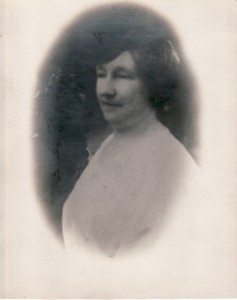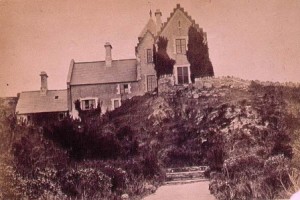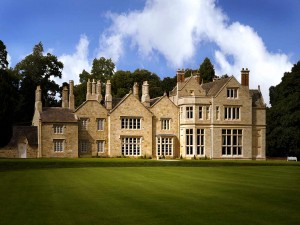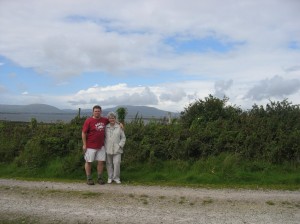When Freda Coulter participated in one of my memoir writing workshop series for North York Central Library’s Canadiana Department, I was so moved by a version of the following family history story that I asked her to share it with you here. Fans of tales about grand estates and the people who lived and worked on them, such as the popular Masterpiece Theatre series Downton Abbey or novels like Kate Morton’s The House at Riverton, will find it intriguing — and inspiring.
Freda is currently writing her memoirs.

Jane Ann Robinson (nee Telford)
“I grew up hearing her mantra, ‘Well, dear, things have to be some way and they’re this way so we best get on with it.’ I know that advice has stood me in good stead over the years.”
Granny was short, ample bosomed, and had a great lap. I remember that, and more.
She had such an influence on me growing up that it had long been a dream of mine to try to trace her steps and see for myself the places she lived and worked in Ireland (at that time Ireland was not divided; it was all part of the U.K.) — from grand estates to a guest house she owned and operated with her daughter, my aunt Dody.
In 2010, thanks to one of my sons, Mike, I realized my dream.
My husband and I had moved our family, including Aunt Dody, to Canada in 1977, five years after my mother passed away. It was the time of “the Troubles,” and although one gets used to the challenges and can live with them, we wanted to give our sons, ages nine and eleven, a wider view of the world. I had visited Ireland often since moving here, and 2010 was to be such a year. But this time, Mike suggested we go together. He and his wife Kate were going to England to see Kate’s mum for a couple of weeks in August, and he and I could stay on another week and go find some of the places Granny had lived. Would I like that?
Would I! I could hardly believe my ears. Over the years I had pieced together Granny’s movements after moving from England back to Ireland shortly after 1900. Now I would get to spend a week combing that beautiful island, and with my son.
§ § §
I was the fourth of six children, and when each of us was about to be born, my aunt Dora (“Dody”), who was ten years older than Mum, would leave Granny and come to stay with Mum for a few days to look after things. But by the time the youngest was due, because of her arthritis Granny couldn’t be alone, so she suggested to Mum, “Come here and bring the two youngest with you.” I was six years old, and my sister Ann was two.
Granny’s home then was a Victorian three-storey terrace house in a seaside town in Northern Ireland. It was here that Helen was born in October of 1946. A couple of weeks later, Dad arrived to take us all home, but Granny said, “Why don’t you leave Freda here until Christmas and get yourself settled.” We had always spent Christmas with Granny and Aunt Dora, and we did so again that December, but afterwards, Granny said, “Why don’t you leave Freda here until Easter.” So I stayed on. And when I went home for Easter, Granny said to Mum, “Why don’t you let her finish out her school year,” so I returned once again!
Granny was like a mother to me, although I also had a close relationship with my own parents. I lived with her and Dody (who never married) while going to school and eventually attending Stranmillis Training College for teachers in Belfast. I was 18 and living in college residence for my first year in 1958 when Granny died at age 89.
§ § §
As I think of Granny, warm memories come flooding back. Like all houses of that era hers had bedrooms with fireplaces complete with mantelshelf. In the mornings when I was small, she would point to a wrapped “sweetie” sitting there and tell me that the little “birdie” had brought it for me. I asked, “How does the birdie get in?” because the windows were kept closed in the winter. She answered, “It can come down the chimney.” Even at six years old I was a bit skeptical, until one morning when I woke up and noticed bird poop on the window. “I suppose that happened as the birdie was on its way to the chimney!” said Granny. She and I kept this up long after we both knew we were playing a game.
Granny taught me to play cards; we would play for hours. We played board games as well. And she taught me to knit. She also gave me my love of reading. She had a quick wit and was a wonderful storyteller. She knew so many Irish sayings and turns of phrase. When I read Maeve Binchy now I can just hear Granny in my head. She took joy in the simplest of things in life – I guess that’s because she didn’t have much.
§ § §
Though Granny rarely talked about her life, I know she had had it hard. She was born Jane Ann Telford on a farm in Ireland in 1869, the eldest of nine children. In the late 1880s she moved to London to find work. My grandfather-to-be, George Robinson, moved there for the same reason. They met while working in a big house in Weston Green in London. She was a parlour maid, and he a coachman and blacksmith. They married in 1892, and Dody was born there the following year. But my grandfather had angina and by 1901 they had moved back to Ireland for his health. His first job there was in County Wicklow.
My grandfather worked on several large estates owned by the landed gentry, who were usually from England and only came to live in Ireland at certain times of the year. When he died suddenly in 1907 in Tipperary, Mum was just four years old and her sister Dora fourteen. There was nothing else for it but for Granny to find work where she could keep her children with her. That meant returning to service in the “big houses.”

The Rock House, Claggan, Ballycroy, County Mayo
She moved first to the west of Ireland and worked as housekeeper to General Clive, whose estate was in County Mayo. She lived in The Rock House when he was in residence, but when he wasn’t there and the house was closed up, she moved to one of the workers’ cottages. In the 1920s, during the Irish Civil War, she worked as housekeeper for Lord Leitrim at Lough Rynn Castle in County Leitrim, and lived in the castle. (Granny remarried there in 1923 – and, according to my dad, what a disaster that turned out to be!)
The next I know of Granny is that by 1932 at age 63 she had left her husband and rented an old Victorian house beside Queen’s University in Belfast and was taking in students.
Four years later, her rheumatoid arthritis got so bad that Dody gave up her job in Derry to take care of her. They rented a house in Bangor, County Down, a seaside place, and started up a guest house. This was the first real home for either of them. And it was there I came to live with them when I was six.
I continued to live with Aunt Dody till I married in 1964, and my husband, children and I brought her with us to Canada in 1977.
Over the years, I heard snippets about life in Ireland in those days from Aunt Dody and Mum and occasionally from Granny herself. Common to all three of them were comments on what it was like to live in the west of Ireland with nothing but the sound of wind howling in the trees, the rain dashing on the bedroom windows, and the roar of the sea. It all sounded so bleak.
How I wish I had asked more questions.
§ § §
In preparing for the trip with Mike, I created a timeline from 1901 to 1946, the year I went to live with Granny. I researched all the places to see if they were still around and in what form.

Lough Rynn Castle, Mohill, County Leitrim
We chose not to visit them chronologically. In fact we started with her last place of employment, Lough Rynn Castle, in Mohill, County Leitrim — now a five-star hotel. As we drove along the winding road to the hotel I remembered hearing Granny talk about the three-mile road running through the estate. She was there during the Irish rebellion and witnessed many disturbing events. There was no farming then — just bush and gardens around the castle.
Sitting in the drawing room of the hotel, looking out over Lough Rynn, I wondered what thoughts had run through her head. She was always pragmatic, after all. I grew up hearing her mantra, “Well, dear, things have to be some way and they’re this way so we best get on with it.” I know that advice has stood me in good stead over the years.
From there we went west, to where she had worked as a housekeeper to General Clive. His 38,000-acre estate was in Claggan, Ballycroy, County Mayo. It was his “holiday place for hunting, fishing and shooting.” Claggan is almost as far west in Ireland as you can go, opposite Achill Island – very remote even now. Driving along these narrow country roads with hardly a house in sight, the ocean on one side and the mountain on the other, I can only imagine how bereft Granny must have felt. She would have been grieving the sudden loss of her husband and the life they’d known – and what must it have been like to come to this desolate place where her employer only lived three weeks of every year and she was alone with the children for the rest.
Little had changed in the hundred years since she was there, and I pictured my mum as a little girl running through the fields and along the shore. Knowing her as I did, I could feel her loss and her pain.
We found the other estates where Granny had worked, five in all – including those in Newtownmountkennedy in County Wicklow, and Templemore in County Tipperary — but none affected us as much as this place.
§ § §

Freda and son Mike on their Irish road trip in search of Granny
A year after this journey, at a family gathering, Mike surprised me with a wonderful gift – a hardcover book titled Finding Granny. He created it online using Shutterfly and it’s full of photographs and anecdotes from our trip.
As I look through it now, I picture us travelling down country roads, getting lost, asking directions, and not quite understanding the dialect. On one road, so narrow it was impossible to drive any faster than 20 kilometres an hour, Mike pointed to a speed limit sign: 80 km. “Do you think we’ll get caught for speeding?” he said, and we laughed.
I was so grateful to have had my son with me on this slow, meaningful journey, a more emotional one than either of us had anticipated. I felt joy at being able to fulfill my dream of retracing Granny’s moves. Through it I felt a greater connection to my grandmother, my mum, and my aunt. It was like stepping into their world of one hundred years ago.
Finding Granny is a precious reminder of that experience.
Freda, you accomplished what few of us do, even though we want to desperately – go back and walk a few steps in our ancestors’ shoes. There was no safety net for our grandparents, just faith, hope, charity and HARD work. There is so much love written into your story, and sharing it with your son is something he will never forget (and may write about one day).
I’m deep into research for a grandfather born in the same era in London’s East End. Bleak, but not in a lonely way, in an overcrowded, impoverished way. Good luck with completing your memoirs.
Mary, thank you for your comments. They have encouraged me. I hope you will find it as engaging as I have done. I really didn’t get anywhere with it until the publishing of the Irish Census of 1901 and 1911. From that I had something to go on. I also called the schools in the various places and with copies of the old roll books I was able to find out how long they stayed in each place. I’m sure you’ve already experienced the thrill of finding out and coming across new information. As you so rightly say in those days there were no safety nets. My grandmother had a very strong faith, worked hard like most did and survived it all. I wish you every success in your journey. There really isn’t anything like it.
Thank you again for your kind comments.
Allyson thank you for this one, and Freda thank you so much for sharing your story! I am delighting in your remembrances especially as your adventure is one I too am committed to. I am working on my grandmother’s story of going into service around the same time, in a big house, at fourteen and marrying the groom and later making a successful business and life in Scotland. Quite a journey for a feisty Catholic in fiercely Protestant Scotland.
Our time frame and some events coincide and even my own story taking me to Bangor Co Down! So there’s a lot here and I have learned from the way you have structured your story and your voice! Thank you and Good Luck!
Thank you Ruth. Enjoy your journey searching. The thrill of uncovering information – some of it quite by accident – gives so much satisfaction.
Freda
Lovely and heartwarming. I recall visiting some of the locations mentioned in County Mayo and County Leitrim. Of course visited Wicklow Estate. A friend and I camped for four weeks around South Ireland in 1994. Freda brought back some beautiful memories for me. Thanks.
Coral.
Thank you Coral. Ireland is indeed a beautiful island. Even though it’s so small, roughly 300 miles by 120, you don’t have to travel very far for the countrside to change dramatically.
Freda